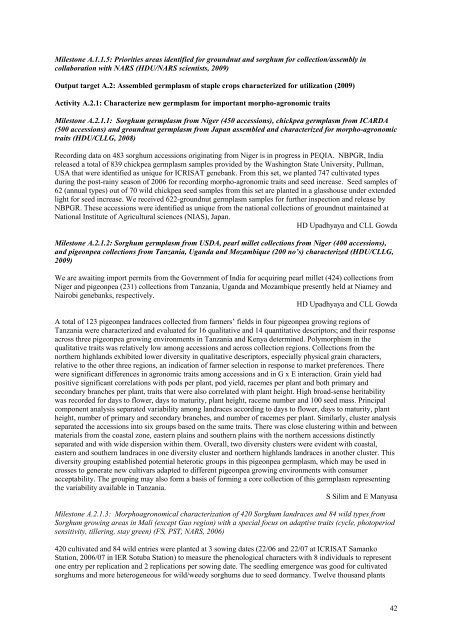ICRISAT Archival Report 2006 - The seedlings of success in the ...
ICRISAT Archival Report 2006 - The seedlings of success in the ...
ICRISAT Archival Report 2006 - The seedlings of success in the ...
Create successful ePaper yourself
Turn your PDF publications into a flip-book with our unique Google optimized e-Paper software.
Milestone A.1.1.5: Priorities areas identified for groundnut and sorghum for collection/assembly <strong>in</strong><br />
collaboration with NARS (HDU/NARS scientists, 2009)<br />
Output target A.2: Assembled germplasm <strong>of</strong> staple crops characterized for utilization (2009)<br />
Activity A.2.1: Characterize new germplasm for important morpho-agronomic traits<br />
Milestone A.2.1.1: Sorghum germplasm from Niger (450 accessions), chickpea germplasm from ICARDA<br />
(500 accessions) and groundnut germplasm from Japan assembled and characterized for morpho-agronomic<br />
traits (HDU/CLLG, 2008)<br />
Record<strong>in</strong>g data on 483 sorghum accessions orig<strong>in</strong>at<strong>in</strong>g from Niger is <strong>in</strong> progress <strong>in</strong> PEQIA. NBPGR, India<br />
released a total <strong>of</strong> 839 chickpea germplasm samples provided by <strong>the</strong> Wash<strong>in</strong>gton State University, Pullman,<br />
USA that were identified as unique for <strong>ICRISAT</strong> genebank. From this set, we planted 747 cultivated types<br />
dur<strong>in</strong>g <strong>the</strong> post-ra<strong>in</strong>y season <strong>of</strong> <strong>2006</strong> for record<strong>in</strong>g morpho-agronomic traits and seed <strong>in</strong>crease. Seed samples <strong>of</strong><br />
62 (annual types) out <strong>of</strong> 70 wild chickpea seed samples from this set are planted <strong>in</strong> a glasshouse under extended<br />
light for seed <strong>in</strong>crease. We received 622-groundnut germplasm samples for fur<strong>the</strong>r <strong>in</strong>spection and release by<br />
NBPGR. <strong>The</strong>se accessions were identified as unique from <strong>the</strong> national collections <strong>of</strong> groundnut ma<strong>in</strong>ta<strong>in</strong>ed at<br />
National Institute <strong>of</strong> Agricultural sciences (NIAS), Japan.<br />
HD Upadhyaya and CLL Gowda<br />
Milestone A.2.1.2: Sorghum germplasm from USDA, pearl millet collections from Niger (400 accessions),<br />
and pigeonpea collections from Tanzania, Uganda and Mozambique (200 no’s) characterized (HDU/CLLG,<br />
2009)<br />
We are await<strong>in</strong>g import permits from <strong>the</strong> Government <strong>of</strong> India for acquir<strong>in</strong>g pearl millet (424) collections from<br />
Niger and pigeonpea (231) collections from Tanzania, Uganda and Mozambique presently held at Niamey and<br />
Nairobi genebanks, respectively.<br />
HD Upadhyaya and CLL Gowda<br />
A total <strong>of</strong> 123 pigeonpea landraces collected from farmers’ fields <strong>in</strong> four pigeonpea grow<strong>in</strong>g regions <strong>of</strong><br />
Tanzania were characterized and evaluated for 16 qualitative and 14 quantitative descriptors; and <strong>the</strong>ir response<br />
across three pigeonpea grow<strong>in</strong>g environments <strong>in</strong> Tanzania and Kenya determ<strong>in</strong>ed. Polymorphism <strong>in</strong> <strong>the</strong><br />
qualitative traits was relatively low among accessions and across collection regions. Collections from <strong>the</strong><br />
nor<strong>the</strong>rn highlands exhibited lower diversity <strong>in</strong> qualitative descriptors, especially physical gra<strong>in</strong> characters,<br />
relative to <strong>the</strong> o<strong>the</strong>r three regions, an <strong>in</strong>dication <strong>of</strong> farmer selection <strong>in</strong> response to market preferences. <strong>The</strong>re<br />
were significant differences <strong>in</strong> agronomic traits among accessions and <strong>in</strong> G x E <strong>in</strong>teraction. Gra<strong>in</strong> yield had<br />
positive significant correlations with pods per plant, pod yield, racemes per plant and both primary and<br />
secondary branches per plant, traits that were also correlated with plant height. High broad-sense heritability<br />
was recorded for days to flower, days to maturity, plant height, raceme number and 100 seed mass. Pr<strong>in</strong>cipal<br />
component analysis separated variability among landraces accord<strong>in</strong>g to days to flower, days to maturity, plant<br />
height, number <strong>of</strong> primary and secondary branches, and number <strong>of</strong> racemes per plant. Similarly, cluster analysis<br />
separated <strong>the</strong> accessions <strong>in</strong>to six groups based on <strong>the</strong> same traits. <strong>The</strong>re was close cluster<strong>in</strong>g with<strong>in</strong> and between<br />
materials from <strong>the</strong> coastal zone, eastern pla<strong>in</strong>s and sou<strong>the</strong>rn pla<strong>in</strong>s with <strong>the</strong> nor<strong>the</strong>rn accessions dist<strong>in</strong>ctly<br />
separated and with wide dispersion with<strong>in</strong> <strong>the</strong>m. Overall, two diversity clusters were evident with coastal,<br />
eastern and sou<strong>the</strong>rn landraces <strong>in</strong> one diversity cluster and nor<strong>the</strong>rn highlands landraces <strong>in</strong> ano<strong>the</strong>r cluster. This<br />
diversity group<strong>in</strong>g established potential heterotic groups <strong>in</strong> this pigeonpea germplasm, which may be used <strong>in</strong><br />
crosses to generate new cultivars adapted to different pigeonpea grow<strong>in</strong>g environments with consumer<br />
acceptability. <strong>The</strong> group<strong>in</strong>g may also form a basis <strong>of</strong> form<strong>in</strong>g a core collection <strong>of</strong> this germplasm represent<strong>in</strong>g<br />
<strong>the</strong> variability available <strong>in</strong> Tanzania.<br />
S Silim and E Manyasa<br />
Milestone A.2.1.3: Morphoagronomical characterization <strong>of</strong> 420 Sorghum landraces and 84 wild types from<br />
Sorghum grow<strong>in</strong>g areas <strong>in</strong> Mali (except Gao region) with a special focus on adaptive traits (cycle, photoperiod<br />
sensitivity, tiller<strong>in</strong>g, stay green) (FS, PST, NARS, <strong>2006</strong>)<br />
420 cultivated and 84 wild entries were planted at 3 sow<strong>in</strong>g dates (22/06 and 22/07 at <strong>ICRISAT</strong> Samanko<br />
Station, <strong>2006</strong>/07 <strong>in</strong> IER Sotuba Station) to measure <strong>the</strong> phenological characters with 8 <strong>in</strong>dividuals to represent<br />
one entry per replication and 2 replications per sow<strong>in</strong>g date. <strong>The</strong> seedl<strong>in</strong>g emergence was good for cultivated<br />
sorghums and more heterogeneous for wild/weedy sorghums due to seed dormancy. Twelve thousand plants<br />
42

















